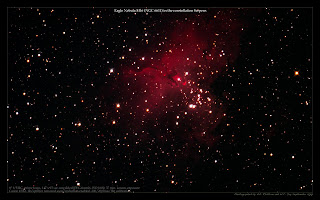My good friend Carl came down and spent an evening (and part of the early morning) with me walking through the paces of setting up the telescope and camera. We had a fantastic dark night, timing couldn't have been better for Carl. We spent much of our time catching up on old times and what's new, but we were able to stay focused enough, pardon the pun, to get a couple shots in.
We chose the Eagle Nebula (M16) first, even though we new it had already passed the meridian and was headed downward toward the West. We still managed to capture a fine picture. I'll post our other shot of Alnitak and the Flame Nebula soon, just being lazy.
Live Star Chart -- Messier Slide Collection -- NGC Slide Series
Click here, to see latest weather radar Vail, AZ from Weather Underground
Get Polaris transit times at the U.S. Naval Oceanography Portal
Thursday, September 16, 2010
Sunday, September 5, 2010
Bubble Nebula, NGC 7635
One last dim target before the stormy weather sets in again. Happy to present this more improved shot of the "bubble", an emission nebula in the constellation of Cassiopeia located near star 4 Cassiopeiae and open cluster M52.
Unguided, 400 x 15 sec. JPEG frames, 100 minutes of accumulated exposure, 1600 ISO, calibrated and such, processed with DDP. No stretching.
Unguided, 400 x 15 sec. JPEG frames, 100 minutes of accumulated exposure, 1600 ISO, calibrated and such, processed with DDP. No stretching.
Saturday, September 4, 2010
Eye of God
Nearly 400 exposures taken of the Helix Nebula in the constellation of Aquarius. This fascinating object is one of the closest planetary nebula to Earth, 700 light-years distant. I first heard of it on the Internet as the "Eye of God"...some silly news article. Had to check it out. Very dim, long exposures needed to detect that anything is there.
Unguided, 393 x 15 sec. JPEG frames, with DDP processing again. I've spent some time now using JPEG format to shorten and simplify the post processing. I think its given notable results. But, now that I've improved, it is probably time to work directly from RAW format. I'm sure I could do a much better job now with this new scope in pulling out detail.
Unguided, 393 x 15 sec. JPEG frames, with DDP processing again. I've spent some time now using JPEG format to shorten and simplify the post processing. I think its given notable results. But, now that I've improved, it is probably time to work directly from RAW format. I'm sure I could do a much better job now with this new scope in pulling out detail.
Friday, September 3, 2010
...when things go wrong
Not every shoot is easy. Things go awry, amiss, or just plain foobar. Below is an example of the Wrong Thing.
Yeah, so cool. Can you guess what the target might be? Bad tracking and a lack of attention to processing detail. Weeeee. This was supposed to have been a retake of the Trifid Nebula. Ahem.
Yeah, so cool. Can you guess what the target might be? Bad tracking and a lack of attention to processing detail. Weeeee. This was supposed to have been a retake of the Trifid Nebula. Ahem.
First light with AT8RC
First night out was a bit awkward, as my first target was cut short by some poor planning on my part. Had I realized before I started that the camera was going to travel right on into the tripod in just 100 or so frames, I would have just taken all the pictures on the other target. Honest, I wasn't drinking. Guess I was just a tad bit excited.
As such, 100 or so frames were certainly not enough to produce good results, but 200+ frames were just fine for a reshoot of the Pinwheel Galaxy, Messier 33 (M33).
Roughly half the diameter of our own Milky Way galaxy, M33 is a mere 3 million light years distant. Certainly nothing like "Five Million Years to Earth." This shoot was unguided, with 237 x 15 sec. JPEG frames, using a modified Canon 450D DSLR. Calibrated, stacked, DDP and unsharp mask applied using Nebulosity.
I love the improved magnification at prime focus with this scope...encourages me to go after some of the more smaller galaxies that I used to have second thoughts about.
As such, 100 or so frames were certainly not enough to produce good results, but 200+ frames were just fine for a reshoot of the Pinwheel Galaxy, Messier 33 (M33).
Roughly half the diameter of our own Milky Way galaxy, M33 is a mere 3 million light years distant. Certainly nothing like "Five Million Years to Earth." This shoot was unguided, with 237 x 15 sec. JPEG frames, using a modified Canon 450D DSLR. Calibrated, stacked, DDP and unsharp mask applied using Nebulosity.
I love the improved magnification at prime focus with this scope...encourages me to go after some of the more smaller galaxies that I used to have second thoughts about.
Subscribe to:
Comments (Atom)




